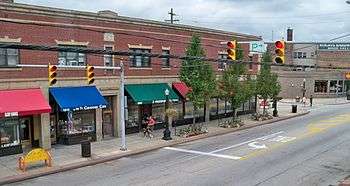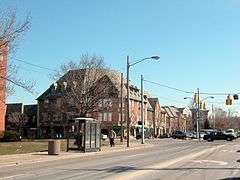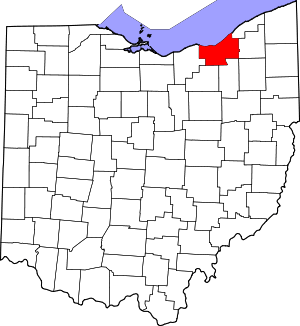Cleveland Heights, Ohio
Cleveland Heights is a city in Cuyahoga County, Ohio, United States, and an inner-ring suburb of Cleveland. The city's population was 46,238 at the 2010 census. As of the 2010 census, Cleveland Heights was ranked the 8th largest city by population in the Greater Cleveland area and ranked 20th in Ohio. It was founded as a village in 1903 and a city in 1921.
Cleveland Heights, Ohio | |
|---|---|
City | |
 Coventry Village in Cleveland Heights. | |
| Nicknames: City Of Trees, Home To The Arts, Neighborhood City, Sharing City | |
 Location in Cuyahoga County and the state of Ohio. | |
.svg.png) Location of Ohio in the United States | |
| Coordinates: 41°30′35″N 81°33′48″W | |
| Country | United States |
| State | Ohio |
| County | Cuyahoga |
| Founded | 1903 (Village) |
| Established | August 9, 1921 (City) |
| Government | |
| • Type | Council–manager |
| • Mayor | Jason S. Stein[1] |
| • Vice Mayor | Kahlil Seren[1] |
| • City manager | Tanisha Briley[2] |
| Area | |
| • Total | 8.08 sq mi (20.94 km2) |
| • Land | 8.06 sq mi (20.89 km2) |
| • Water | 0.02 sq mi (0.05 km2) |
| Elevation | 935 ft (285 m) |
| Population | |
| • Total | 46,238 |
| • Estimate (2019)[6] | 43,992 |
| • Density | 5,454.68/sq mi (2,105.96/km2) |
| Time zone | UTC-5 (Eastern (EST)) |
| • Summer (DST) | UTC-4 (EDT) |
| ZIP codes | 44121, 44112, 44118, 44106 |
| Area code(s) | 216 |
| FIPS code | 39-16014[7] |
| GNIS feature ID | 1048605[4] |
| Website | Official website |
History
The area that is now Cleveland Heights was settled later than most of Cuyahoga County. The first road through what is today the city, Mayfield Road, was not built until 1828. Some of the land was divided into farms, but It also had quarries in the 19th century. One of the early quarries was established by Duncan McFarland who mined bluestone. This led to the settlement that grew up around the quarry for the workers to live in to be referred to as Bluestone. There is still a road of this name in that area.
In 1873 John D. Rockefeller acquired about 700 acres in what is now the cities of East Cleveland and Cleveland, with his mansion itself in East Cleveland. Eventually some of the land, straddling both suburbs, was turned into residential developments and, in 1938, the family donated land which is now Forest Hill Park. There had been quarries within what is today Forest Hill Park previous to Rockefeller donating it to the city.
Rockefeller was not the only affluent Clevelander to come to what is now Cleveland Heights. The Euclid Heights development was created by Patrick Calhoun starting in 1892. It was centered around the Euclid Golf Course and began at the Cleveland city line, covering the area between Mayfield and Cedar roads as far east as Coventry Road. There was a streetcar line from this location running to the center of Cleveland's business district.
In 1898 Marcus M. Brown began the development of Mayfield Heights along the south side of Mayfield Road and east of the current Coventry Road - taking advantage of the Mayfield Road streetcar. Brown had purchased this land from Emil Preyer and his sister Mary Preyer Hellwig. Emil was operator of a cedar mill.
By the end of 1899 the streetcar reached out along Mayfield Road to the old village of Fairmount. In 1903 the village of Cleveland Heights was incorporated.[8] In 1910 Cleveland Heights had a population about 5,000 people. It had a population of 15,396 in 1920 and was incorporated as a city on August 9, 1921. By 1960 it had a population of 61,813.[9]
Geography

Cleveland Heights is located at 41°30′35″N 81°33′48″W (41.509652, -81.563301).[10]
According to the United States Census Bureau, the city has a total area of 8.13 square miles (21.06 km2), of which 8.11 square miles (21.00 km2) is land and 0.02 square miles (0.05 km2) is water.[11] Cleveland Heights is made up of three watersheds, the Doan Brook Watershed, the Dugway Brook Watershed, and the Nine Mile Creek Watershed.[12] Approximately 50% of Cleveland Heights is part of the Dugway Brook Watershed.[13]
Environment
In 1987, the city of Cleveland Heights was declared a nuclear-free zone.[14]
Demographics
| Historical population | |||
|---|---|---|---|
| Census | Pop. | %± | |
| 1910 | 2,955 | — | |
| 1920 | 15,236 | 415.6% | |
| 1930 | 50,945 | 234.4% | |
| 1940 | 54,992 | 7.9% | |
| 1950 | 59,141 | 7.5% | |
| 1960 | 61,813 | 4.5% | |
| 1970 | 60,767 | −1.7% | |
| 1980 | 56,438 | −7.1% | |
| 1990 | 54,052 | −4.2% | |
| 2000 | 49,958 | −7.6% | |
| 2010 | 46,238 | −7.4% | |
| Est. 2019 | 43,992 | [6] | −4.9% |
| Sources:[7][15][16] | |||
As of the census[5] of 2010, there were 46,238 people, 19,957 households, and 10,834 families residing in the city. The population density was 5,686.9 inhabitants per square mile (2,195.7/km2). There were 22,465 housing units at an average density of 2,770.0 per square mile (1,069.5/km2). The racial makeup of the city was 49.8% White, 42.5% African American, 0.2% Native American, 4.1% Asian, 0.6% from other races, and 2.8% from two or more races. Hispanic or Latino of any race were 2.0% of the population.
There were 19,957 households of which 26.2% had children under the age of 18 living with them, 35.6% were married couples living together, 15.2% had a female householder with no husband present, 3.4% had a male householder with no wife present, and 45.7% were non-families. 36.1% of all households were made up of individuals and 10.4% had someone living alone who was 65 years of age or older. The average household size was 2.27 and the average family size was 3.05.
The median age in the city was 35.8 years. 22.3% of residents were under the age of 18; 10.6% were between the ages of 18 and 24; 27.9% were from 25 to 44; 25.9% were from 45 to 64; and 13.5% were 65 years of age or older. The gender makeup of the city was 46.6% male and 53.4% female.
The median income for a household in the city was $53,024. The per capita income for the city was $31,663. About 19.3% of individuals were below the poverty line.[17]
Politics and government
Cleveland Heights is governed by a city charter adopted in 1921 and amended in 1972, 1982, and 1986. The charter specifies a council–manager form of government, with seven members of council elected to four-year terms. Three councilmembers are elected one year before a presidential election, and three one year after a presidential election. All are elected using plurality at-large non-partisan voting. The Council President (with the ceremonial title of Mayor) is elected by council from among its members in January after every Council election and has additional duties including parliamentary and ceremonial responsibilities.
Cleveland Heights is reliably Democratic. Five of the six current members of Council are Democrats. In the 2008 presidential election, Barack Obama defeated John McCain 84.2%-15.0% while winning the state, while in the 2004 presidential election, John Kerry defeated George W. Bush 80.8%-18.8% in the city but was unable to win the state. In 2012, every precinct in the city was carried by Barack Obama. All of Cleveland Heights is in the 11th congressional district, a seat currently held by Marcia Fudge, elected in a special election following the death of Rep. Stephanie Tubbs Jones. In 2003, voters supported a referendum to establish a domestic partnership registry; Cleveland Heights was the first Ohio city to establish one.[18]
The current city council is composed of Mayor Jason S. Stein, Vice Mayor Kahlil Seren, Mary Dunbar, Melody Joy Hart, Davida Russell, and Michael Ungar.[19] The seventh position on city council is currently vacant as of August 2020.[20]
Education
Public education in the city of Cleveland Heights is provided by two school districts. Most of the city is served by the Cleveland Heights-University Heights City School District, while a small portion located on the northwest side of the city lies within the East Cleveland City School District.
Several private schools are located within the city, including Beaumont School, Lutheran High School East, Horizon Montessori, Ruffing Montessori, Hebrew Academy of Cleveland, Saint Ann School, Mosdos Ohr Hatorah, and Yeshiva of Cleveland.
Notable people
- Gina Abercrombie-Winstanley, diplomat
- Albert Ayler, jazz musician
- Hector Boiardi, A.K.A. Chef Boy-Ar-Dee; started his business in the early 1930s while living in Cleveland Heights.[21]
- Timothy Broglio, Archbishop for the Military Services, USA.[22]
- Eric Coble, playwright
- Eric Fingerhut, former congressman; president/CEO of Hillel: The Foundation for Jewish Campus Life
- Margaret Hamilton, actress
- Herman Goldner, mayor of St. Petersburg, Florida, 1961–67 and 1971–73; reared in Cleveland Heights[23]
- Joel Grey, Tony and Oscar winning actor
- Dave Hill (comedian), Comedian, radio host, and musician
- Diana Hyland, actress
- Darrell Issa, congressman (CA-49)
- Barry Cofield, NFL player
- Bill Kennedy, actor, television personality
- Ron Klein, former congressman from Florida, attorney
- Michael Krasny, English professor and talk show host
- Steve LaTourette, former congressman; president/CEO of Republican Main Street Partnership
- Clea Lewis, actress and singer
- Dean Martin, singer, actor
- Harvey Pekar, author, graphic novelist, jazz critic
- Michael Ruhlman, author, cook, entrepreneur
- Viktor Schreckengost, industrial designer, artist
- Justine Siegal, baseball coach
- Dr. Benjamin Spock, pediatrician, anti-Vietnam War activist
- Ivan Stang, film maker, publisher, broadcaster
- Robert D. Storey, philanthropist and corporate director
- Debra Winger, actress
- Sean Young, actress
- Jason Kelce, NFL player, Philadelphia Eagles
- Travis Kelce, NFL player, Kansas City Chiefs
- Jack Stratton, Vulfpeck Band Leader
See also
References
- "City Council". Retrieved May 10, 2018.
- "City Manager's Office". Retrieved May 10, 2018.
- "2019 U.S. Gazetteer Files". United States Census Bureau. Retrieved July 27, 2020.
- "US Board on Geographic Names". United States Geological Survey. October 25, 2007. Retrieved January 31, 2008.
- "U.S. Census website". United States Census Bureau. Retrieved January 6, 2013.
- "Population and Housing Unit Estimates". Retrieved May 21, 2020.
- "U.S. Census website". United States Census Bureau. Retrieved January 31, 2008.
- "History of Cleveland Heights". clevelandheights.com. Retrieved April 9, 2018.
- Columbia Lippincott Gazetteer, 1952 Edition with 1962 Supplement.
- "US Gazetteer files: 2010, 2000, and 1990". United States Census Bureau. February 12, 2011. Retrieved April 23, 2011.
- "US Gazetteer files 2010". United States Census Bureau. Archived from the original on June 26, 2012. Retrieved January 6, 2013.
- "Watersheds | Cleveland Heights, OH". www.clevelandheights.com. Retrieved June 18, 2020.
- "Wayback Machine" (PDF). April 2, 2015. Archived from the original (PDF) on April 2, 2015. Retrieved June 18, 2020.
- "Signs announcing Cleveland Heights as Nuclear Free Zone: Whatever happened to ...?". cleveland.com. Retrieved April 9, 2018.
- "Number of Inhabitants: Ohio" (PDF). 18th Census of the United States. U.S. Census Bureauaccess-date=26 April 2020. 1960.
- "Ohio: Population and Housing Unit Counts" (PDF). U.S. Census Bureau. Retrieved November 22, 2013.
- "Cleveland Heights (city) QuickFacts from the US Census Bureau". www.census.gov. Retrieved May 4, 2017.
- http://www.clevelandheights.com/280/Domestic-Partner-Registration
- https://www.clevelandheights.com/524/City-Council
- https://www.clevescene.com/scene-and-heard/archives/2020/03/03/cleveland-heights-councilwoman-and-former-vice-mayor-melissa-yasinow-resigned-last-night
- "Cleveland Heights Historical Society - Feature Stories". www.chhistory.org. Retrieved April 9, 2018.
- "Timothy P. Broglio". www.nndb.com. Retrieved April 9, 2018.
- "Andrew Meacham, "Mayor packed ideas, pipe tobacco in rich public life," September 15, 2010". Tampa Bay Times. Archived from the original on June 5, 2014. Retrieved June 1, 2014.
External links
| Wikimedia Commons has media related to Cleveland Heights, Ohio. |

.svg.png)
